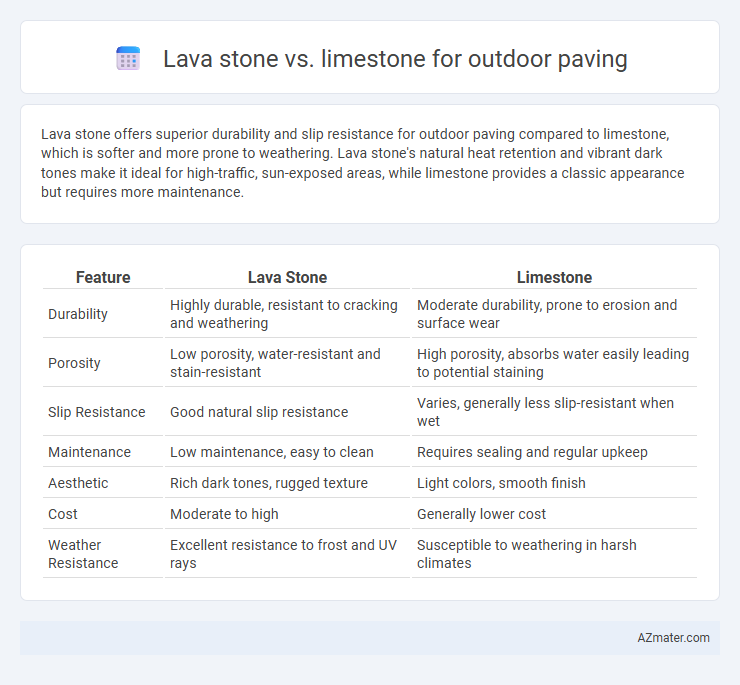Lava stone offers superior durability and slip resistance for outdoor paving compared to limestone, which is softer and more prone to weathering. Lava stone's natural heat retention and vibrant dark tones make it ideal for high-traffic, sun-exposed areas, while limestone provides a classic appearance but requires more maintenance.
Table of Comparison
| Feature | Lava Stone | Limestone |
|---|---|---|
| Durability | Highly durable, resistant to cracking and weathering | Moderate durability, prone to erosion and surface wear |
| Porosity | Low porosity, water-resistant and stain-resistant | High porosity, absorbs water easily leading to potential staining |
| Slip Resistance | Good natural slip resistance | Varies, generally less slip-resistant when wet |
| Maintenance | Low maintenance, easy to clean | Requires sealing and regular upkeep |
| Aesthetic | Rich dark tones, rugged texture | Light colors, smooth finish |
| Cost | Moderate to high | Generally lower cost |
| Weather Resistance | Excellent resistance to frost and UV rays | Susceptible to weathering in harsh climates |
Introduction to Outdoor Paving Materials
Lava stone offers exceptional durability and heat resistance, making it ideal for high-traffic outdoor paving areas in warm climates. Limestone provides a softer, more natural aesthetic with excellent slip resistance, commonly used in patios and garden pathways. Both materials vary in porosity and maintenance needs, affecting longevity and weather performance in outdoor environments.
Lava Stone: Composition and Characteristics
Lava stone, primarily composed of basalt, is an igneous rock formed from cooled volcanic lava, known for its dense, fine-grained texture that provides exceptional durability for outdoor paving. Its naturally porous surface enhances slip resistance, making it ideal for wet or high-traffic areas, while its heat retention properties keep surfaces cooler under direct sunlight compared to limestone. Unlike limestone, which is sedimentary and prone to weathering and acid rain damage, lava stone offers superior resistance to erosion and staining, ensuring long-lasting performance and low maintenance in outdoor environments.
Limestone: Composition and Characteristics
Limestone, composed primarily of calcium carbonate, is a sedimentary rock widely used for outdoor paving due to its durability and natural aesthetic appeal. Its porous surface provides excellent traction, making it a safe choice for walkways and patios while also allowing it to weather gracefully over time. Unlike lava stone, limestone offers a lighter color palette and smoother texture, enhancing outdoor spaces with a classic, elegant look that remains resilient in various climates.
Visual Appeal: Lava Stone vs Limestone
Lava stone offers a striking visual appeal with its rich, dark hues and unique porous texture, creating a bold, contemporary look for outdoor paving. Limestone provides a softer, more traditional aesthetic with its lighter shades and subtle grain patterns, enhancing outdoor spaces with natural elegance and warmth. Choosing between lava stone and limestone depends on the desired ambiance, where lava stone embodies modern sophistication and limestone evokes classic charm.
Durability and Weather Resistance
Lava stone offers exceptional durability and weather resistance due to its volcanic origin, making it highly resistant to cracking, chipping, and erosion in outdoor paving applications. Limestone, while aesthetically appealing and widely used, is more porous and prone to weathering, especially in freeze-thaw climates where it may deteriorate faster. For long-term outdoor paving projects requiring robust performance against harsh weather conditions, lava stone provides superior longevity and structural integrity compared to limestone.
Slip Resistance and Surface Texture
Lava stone offers superior slip resistance for outdoor paving due to its naturally rough and porous surface texture, which enhances grip even when wet. Limestone, characterized by a smoother and more polished finish, tends to be more slippery and requires additional treatments to improve traction. The textured ruggedness of lava stone makes it a safer option for outdoor areas prone to moisture and heavy foot traffic.
Maintenance Requirements
Lava stone offers superior durability and minimal maintenance for outdoor paving due to its dense, non-porous surface that resists staining and weathering. Limestone, being a softer sedimentary rock, requires regular sealing and more frequent cleaning to prevent erosion, staining, and surface degradation. Choosing lava stone reduces long-term upkeep efforts and costs in high-traffic or exposed outdoor areas.
Installation Considerations
Lava stone offers durability and excellent slip resistance, making it ideal for outdoor paving installations where safety is crucial, and it requires minimal sealing compared to limestone. Limestone, while softer and more porous, demands careful sealing and regular maintenance to prevent staining and weathering, especially in areas with heavy rainfall or freeze-thaw cycles. Installation of lava stone involves precise cutting due to its hardness, whereas limestone is easier to shape but needs a stable base to avoid cracking under pressure.
Cost Comparison: Lava Stone vs Limestone
Lava stone outdoor paving typically costs between $15 to $30 per square foot, reflecting its durability and unique volcanic texture, whereas limestone ranges from $10 to $25 per square foot, generally offering a more affordable option with a smoother finish. Maintenance expenses for lava stone tend to be lower due to its resistance to weathering and stains, while limestone may require more frequent sealing and cleaning to preserve its appearance. Both materials provide long-term value, but initial cost differences and upkeep requirements are critical factors influencing budget choices for outdoor paving projects.
Best Uses and Final Recommendations
Lava stone offers exceptional durability and heat resistance, making it ideal for high-traffic outdoor paving areas and environments exposed to intense sunlight. Limestone provides a softer, more natural texture with excellent drainage properties, perfect for garden pathways and decorative patios. For heavy-duty and heat-prone applications, choose lava stone, while limestone suits aesthetic-focused, low-traffic outdoor spaces.

Infographic: Lava stone vs Limestone for Outdoor paving
 azmater.com
azmater.com